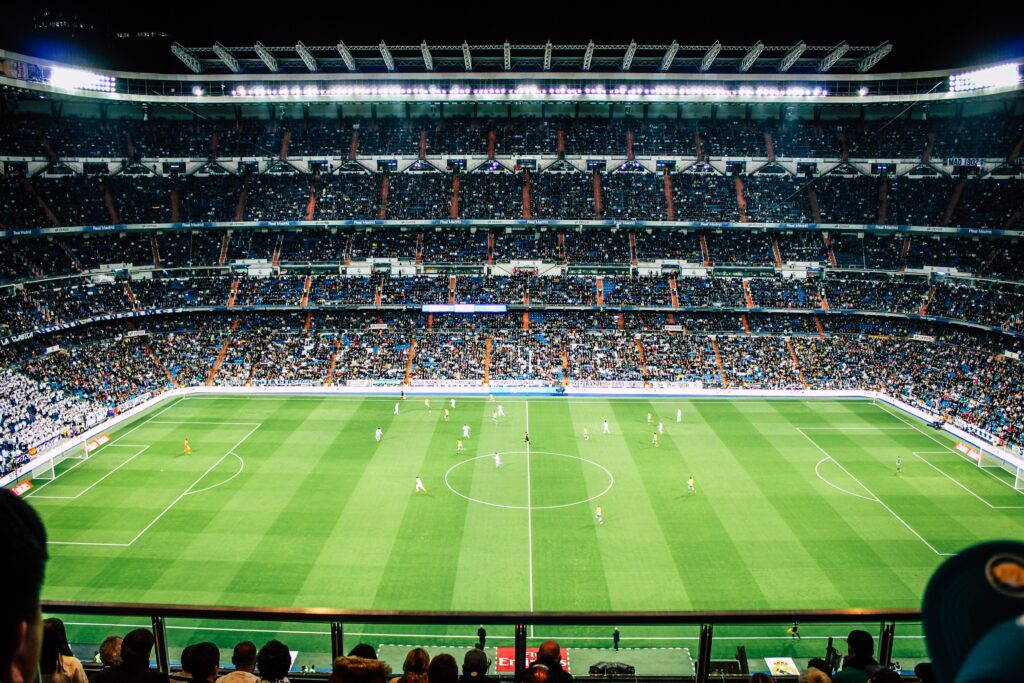If you’ve ever looked at a soccer field and wondered why the dimensions are so important, it’s because there are quite a few factors that are important to take into consideration. While every surface has its own characteristics, soccer fields have many different variables that need to be considered when constructing them.

It might not be noticeable right away, but after watching several soccer games, you may recognize that professional clubs around the world play at different soccer field sizes. So, you might be wondering then, what are the dimensions of a standard soccer field and why are they so important?
What Is the Standard Dimension for a Soccer Field?
According to International Football Association Board (IFAB) and the FIFA (Fédération Internationale de Football Association), a regulation field size is between 110 to 120 yards long, and 70 to 80 yards wide. Several professional soccer fields vary in size, but the ideal soccer field dimensions are 360 feet long (120 yards) by 225 feet wide (75 yards).
This serves as a good example of the dimensions of a professional soccer field. However, there are also other field sizes used for playing soccer, especially at the high school and college levels.
This can have a varying effect on how the game will be played by each team involved as well as other factors. Let’s dive into why soccer field dimensions are important.
Why Are Soccer Field Dimensions Important?
1. Field Size and Groundcover
Soccer field dimensions are important because they can impact what kind of surface the groundcover is and how much grass it needs to grow. The most critical thing when determining dimensions is knowing the correct size for your field so that you can get the right type of groundcover in place.
An essential aspect of playing and coaching is impacted by soccer field dimensions. These dimensions influence a number of different factors, such as the size of the team and the speed at which they can play. Players need to be in tune with these details to get the most out of their use on the field.
The dimensions of a soccer field are vital to the game itself. Understanding soccer field dimensions can help you make the right decision when it comes to playing or building one.
2. Homecourt Advantage and Style of Play
A part of soccer culture and how the way the league works is by allowing different field sizes. This gives soccer clubs a field advantage when they are playing at their home stadium.
Soccer clubs get the chance to adjust the size of their home field based on the way they play and that gives them an advantage against their opponent.
Not only that but they gain an audience advantage by playing in their own stadium. They will have more cheers from the crowd increasing their morale. Additionally, the team playing in their home stadium can gain the advantage by picking a field size that fits their playstyle.
Take for example a soccer team using a defensive strategy like “Parking the bus” to take the win or end the match with a draw. A pitch with a small dimension will work in favor of this team. This is because the players will have to cover a smaller area to prevent their opponent from scoring.
Having a smaller field allows the team players to concentrate in a smaller area in front of the goal instead of having to spread out to cover a wide area in the case of a large field.
The same can be said for teams who rely on counterattacks. They would require large fields to have more freedom to maximize their movement and add more spaces when heading towards the goal of the opposing team.
3. Player’s Physical Abilities
This brings us to our next factor which would be the player’s physical abilities. Not all soccer teams have the experience required to ensure that their players are competent enough to play a full 90-minute soccer match.
The performance of soccer players on large fields will have some loss in performance towards the end of the game. This may also be exacerbated during the game’s second half and especially during the extra halves that could be added at the end of the game.
For this reason, soccer clubs will go for smaller soccer fields knowing that their players’ stamina is fit for smaller fields.
4. Budget and Location Limitations
Lastly, not all soccer clubs are able to afford to build and maintain large pitches. This is why the soccer rules allow the field of play to be within a flexible range as some clubs might not be able to build one due to limitations in the location and maintenance of the field that’s covered with either natural or hybrid grass.
Final Thoughts
Different field sizes allow different soccer clubs to play in a field that fits their playstyle when playing in a home match. This also means that more soccer clubs will be able to afford to have their own official stadium by building smaller-sized stadiums.
Some people may think that it is unfair but the way most soccer leagues function is that a team plays two matches against the same opponent. One match on their opponent’s field which is called an away match and the other on their own field called a home match.
Both teams are given the advantage as they will get a chance to play on their home field against their opponent. The great thing about this is that players will strategize and more people will be able to play soccer regardless of the limitations mentioned.

